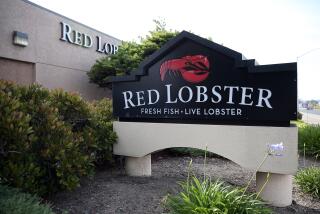Seafood Is Just What the Doctor Ordered : Nutrition: Study says for the most part restaurants serving fish and other ocean fare get high marks.
- Share via
WASHINGTON — At long last, praise!
The nutrition activists who scared many people away from Mexican, Chinese and Italian restaurants and denounced the high saturated-fat content of movie theater popcorn are back again. But this time the message is strikingly upbeat.
A nutritional analysis performed by the Washington-based Center for Science in the Public Interest and released Wednesday shows that the nation’s seafood restaurants, for the most part, are serving up healthy fare.
“We found more healthy, low-fat and delicious choices available at seafood restaurants than at any other restaurants we’ve seen,” said Jayne Hurley, the group’s senior nutritionist. “Bake it, broil it, blacken it, grill it--as long as you don’t fry it, seafood is a great catch.”
Compared to the nutritional value of the other restaurants the center studied, menus in seafood establishments offer an array of low-fat choices, more options for healthier side dishes and sodium levels which--although high--were far below the “stratospheric levels” found in Chinese, Italian and Mexican restaurants.
The nutrition center is a consumer advocacy and education organization founded in 1971 that specializes in food and nutrition issues. It promotes healthful eating through diets that are low in saturated fat, cholesterol, sugar, salt and processed foods.
The center has drawn the wrath of some nutritionists and food industry officials who complain that, in a quest for media attention, it has exaggerated the dangers of certain foods that are virtually harmless if eaten in moderation.
In response to the study, the National Fisheries Institute, a seafood trade organization that represents 1,000 companies, including restaurants, emphasized that seafood restaurants offer numerous preparation options for individuals concerned about their diets. But the institute added: “Fried items, including fried seafood, can be enjoyed in moderation along with a balanced and sensible diet over the course of several meals or several days.”
Diets high in saturated fats have proved to be--or are suspected of being--associated with numerous serious or life-threatening medical conditions, including heart disease, obesity and certain kinds of cancers.
The center began studying restaurants a year ago because “more than 40% of the American food dollar is spent outside the home, yet consumers have little idea what they are eating when dining out in a restaurant,” the center said.
It offered kudos to those restaurants and movie theaters that have made positive changes in the year since its reports began coming out.
Michael Jacobson, the center’s executive director, singled out Chi-Chi’s, the Mexican restaurant chain, for introducing a new menu nationwide that prominently features several lower-fat meals and appetizers.
Also, the chain now offers to prepare any entree on its menu with reduced-fat cheeses, he said. “Chi-Chi’s is to be congratulated,” Jacobson said.
Also, after the center’s April report condemning the coconut oil used in movie theater popcorn, only one of the 10 largest theater chains still uses it, and that chain--United Artists--offers air-popped popcorn as an alternative, Jacobson said.
For its seafood study, the organization purchased 14 of the most popular seafood dishes at 32 mid-priced restaurants in Boston, Chicago, Los Angeles, Seattle and Washington, including the nation’s largest seafood chain, Red Lobster, as well as smaller regional chains and independents.
Each sample was individually dissected and its components weighed. Then composite samples of each dish were sent to an independent testing laboratory for nutritional analysis.
The group said that baked, broiled, blackened, grilled or steamed seafood--including flounder, cod, haddock, sole, shrimp, scallops, crabs and clams--were the best nutritional picks. A seafood meal with a baked potato topped with a tablespoon of sour cream, a salad with a tablespoon of low calorie dressing and two dinner rolls with half a pat of butter on each, averaged 723 calories with 18 grams of fat, the center said.
But not all seafood meals are created equal: A fried seafood combination platter, served with tartar sauce, french fries, cole slaw and buttered biscuits, contained 2,178 calories and a whopping 130 grams of fat, about as much fat as a person should consume in two full days, the group said.
“A fried seafood combo (is) almost as bad as fettuccine alfredo, the infamous heart attack on a plate, and the most unhealthful entree CSPI has ever analyzed,” the group said.
The group criticized the Red Lobster chain for frying fish in a highly hydrogenated solid shortening rather than in true oil. The shortening, which comes in solid block form, contains high levels of trans fats that act like saturated fat in increasing cholesterol levels.
Saturated fats are turned into cholesterol by the body. Hurley said that this type of shortening “is worse than lard for consumers’ hearts.”
Dick Monroe, a spokesman for the restaurant chain, said that “whether the vegetable oil used at Red Lobster is more healthful in a solid versus liquid form has been the subject of discussion among nutritionists, dietitians and others.”
He added that “we strive to satisfy the needs of both the health-conscious diner and the one who enjoys an occasional indulgence. At Red Lobster, our guests choose what they want and how they want it prepared.”
Jacobson said that individuals who carefully monitor their cholesterol intake should avoid shrimp--and choose scallops instead. An average order of shrimp has between 100 and 150 milligrams of cholesterol.
But “if you’re not watching your cholesterol, that isn’t a terrible amount,” he said.
More to Read
Eat your way across L.A.
Get our weekly Tasting Notes newsletter for reviews, news and more.
You may occasionally receive promotional content from the Los Angeles Times.










